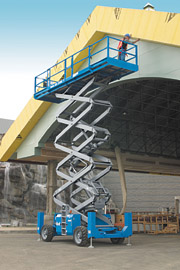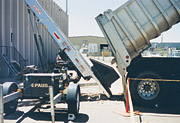
It is no surprise that, year after year, more construction workers die from falling from a height above 6 feet, with an annual average of 32 to 35 percent. Most surprising, according to the Bureau of Labor Statistics, is that between 1993 and 1999, general construction averaged 18 boom lift- and eight scissor lift-related deaths each year. Painters (SIC #1721) and drywallers and tapers (SIC#1742), however, have the fourth highest overall fall fatality rate behind those of roofers, ironworkers and electricians.

Aerial and scissor lift accident statistics
What is most alarming is that the root causes of most of these falls are reported to be unsafe acts or unsafe conditions on some type of scaffolding. While 32 percent of drywaller/taper fatal accidents occurred using either supported or suspended scaffolding, as much as 40 percent of painters’ fatal falls can be attributed to scaffold use. Considering all of these trades in a single category, the average scaffold-related death is 36 percent.With the increased availability and versatility of manually propelled mobile scaffolds, scissor lifts and aerial lifts to these trades, the ratio of falls from these types of equipment is relatively large. Compared to 3 percent aerial lift deaths in general construction, painters and drywallers incur more than 17 percent of the fatal falls involving activities on mobile elevated work platforms. There were 10 percent more fatalities associated with scissor lifts than aerial boom lifts, probably due to their popularity with the painting and drywall trades.
After reviewing and analyzing elevated, mobile work platform accidents in construction during the mid ‘90s, the OSHA Standards Committee deemed it important to include scissor lifts and aerial lifts in the latest (1998) revision of the construction scaffold standard (1926.450). Their investigations revealed that many of contributing unsafe acts and conditions that led up to these particular construction fatalities (1993-1999) were identical in many respects to those of supported scaffold accidents. For the drywallers and painters, the 10 major hazardous activities in manlifts included:
1. Operating on an uneven surface
2. Encountering holes, debris and drop-offs while operating elevated
3. Climbing above or leaning over the 42-inch minimum top rail
4. Overloading and collapsing the boom (i.e. using a manlift as a material crane)
5. Making contact with electrical conductors with an uninsulated portion of the lift
6. Neglecting to deploy outriggers or brace sufficiently against tip-over
7. Making body contact with electrical conductors or entering the induction field
8. Operating the lift in inclement weather or low visibility conditions
9. Inexperienced or untrained operators
10. Unobserved, uncorrected mechanical or structural defects in equipment
While some fatality victims were struck by objects, such as booms and baskets, a smaller percentage was crushed between either the carriage or the basket and some fixed structure. Falls from the elevated platform seemed to be caused primarily by a worker’s unsafe acts, such as leaving gate chains unattached, propping the gate open, or climbing up on or leaning over the guardrail system. Some even fell from step and extension ladders that were set up inside the platform.

The aerial lift JSA
The only means safety consultants have to reverse any trend in injury and fatality rates is to observe, analyze and recommend. Using a Job Safety (or Hazard) Analysis format facilitates the compilation of observable data to achieve a reproducible, statistical effect. This JSA form is comprised of four vertical columns:1. Phases of the project broken down into individual steps
2. The observed hazard(s) associated with each step
3. One or more of the three hazard controls (engineering, administrative and personal protective equipment) used to remove or reduce the hazard
4. The estimated cost of column #3.
OSHA recommends a three-column JSA, but there had better be a line item for safety in the bid or the cost of compliance will inevitably come out of profit and overhead. The JSA is site and task specific and, as such, satisfies many of OSHA’s competent person duties. Moreover, when an employer has a consistent near-miss reporting system, in addition to accident reporting, the data field can expand significantly. Many of those close-call events, which would normally miss reporting and evaluation, give the safety consultant an additional quantity of non-injurious episodes to analyze. It doesn’t take much to convert a near-miss into a tragic accident wherever scaffolds are employed.
Definition of terms
One of the problems I’ve encountered with contractors who are trying to understand the revised scaffold standard involves the definition of an “aerial lift.” Just what does this category of equipment include? What does it exclude?An aerial lift is any powered, mobile vehicle-mounted device that may elevate, telescope extend, articulate and may (or may not) rotate around a substantial axis in order to raise and support personnel to elevated job sites. Aerial lifts include extendible boom platforms; vehicle-mounted aerial ladders; articulating, rotating boom platforms; vertical self-elevating towers; and any other equipment built in accordance with either ANSI-A92.2 (1990), Vehicle-Mounted Elevating and Rotating Aerial Devices, or ANSI-A92.5 (1992) Boom Supported Elevating Work Platforms.
Mobile scaffolding is considered by OSHA to be a portable, mobile, caster or wheel-mounted scaffold system, either manufactured or site erected, powered or unpowered, in which the elevated work platform is positioned vertically (plumb) — directly over the base frame dimension or motorized carriage. If constructed on site, it is often built from pinned, welded endframes (steel or aluminum); horizontal and vertical cross braces; and aluma-deck or OSHA plank platforms.
Scissor lifts are a subcategory of the mobile scaffolding. They may be either electric, gas, propane or diesel-powered. The personnel work platform is mechanically raised vertically above the carriage by means of controls on the platform operating a
framework of adjustable levers and fulcrums. The equipment is designed and fabricated according to either ANSI-A92.6 (1990), Self-Propelled Elevating Work Platforms, or ANSI-A92.3 (1990), Manually Propelled Elevating Aerial Platforms.
The rate load of a scissor or aerial lift is the manufacturer’s specified maximum load that is applied to the manbasket or platform. This weight (in pounds) should be clearly marked on the vehicle and platform, as well as noted in the operator’s manual. According to ANSI-A92.2 and OSHA 1926.451(a)(1), “A component shall be capable of supporting without failure, its own weight and at least four times the maximum load applied on or transmitted to it.” In order to receive ANSI compliance certification, aerial lifts are engineered to have this calculated safety factor incorporated into their posted maximum rated load.
A competent person is an employer-designated employee who is: 1) experienced in aerial and scissor lifts; 2) thoroughly trained in the operations of the specific lift model; 3) currently trained in the pertinent OSHA/ANSI standards; 4) capable of identifying any and all existing and potential hazards associated with aerial/scissor lifts; 5) authorized by the employer to take “prompt corrective measures” to eliminate hazards; 6) capable of implementing engineering, administrative and personal protective equipment hazard controls.
The OSHA scaffold standard, enforced on September 2, 1997, (1926.451(a)(3)) states that: “No scaffold shall be erected, moved, dismantled or altered except under the supervision of competent persons.” As with all scaffolding in Subpart L, this applies to manually propelled and powered mobile scaffolds (scissor lifts), as well as aerial lifts (boom lifts). If an OSHA compliance officer should arrive to inspect your job site, you can be sure he will ask to speak to your competent person. If you have no one or you’ve designated untrained and inexperienced personnel, you will undoubtedly receive a standard violation. If the hazards are particularly egregious, you may even receive a “serious” or “willful” violation, because you knew a competent person was required on site, but chose not to train and evaluate adequately.
The most important trait for any competent person is his ability to prioritize any work tasks behind hazard assessment and mitigation. Contractors often tell me that the person with enough training and experience in the subject matter is usually a foreman or lead worker, who naturally considers profitability and productivity ahead of safety. Nothing should come before safety. Be prepared by designating and preparing a responsible competent person whenever working with aerial lifts.
Safety features
There are dozens of manufacturers of aerial and scissor lifts from all over the world. Some of the primary manufacturers include Grove, JLG, Genie, Snorkel, Skyjack and UpRight. Every manufacturer offers numerous models to choose from, with a wide range of standard and optional features and accessories. Many of these features were developed to become compliant with either the current OSHA or ANSI standards, while still others were engineered as solutions to meet specific construction or maintenance market demands. Some of these items include: a self-leveling platform or basket; AC/DC wired outlets in basket; interlock control on safety gate; redundant foot control lock-out; automatic leveling outriggers; tilt sensor-alarm; motion alarm; voltage “sniffer” and alarm; built-in two-way radio and pothole protection.While many of these improvements may increase the safety factor of the aerial or scissor lift, if they are not regularly inspected and maintained, they may only provide a false sense of security. The best feature of any automatic interlock system (foot switch, gate switch, outrigger pressure switch) is that it does not need activation to be effective. If there is anything you can be sure of, however, it is that almost any safety device may be bypassed. Any employee who would jam a shim block into the safety foot switch may also consider climbing a 6-foot stepladder set up on the platform.
Regardless of the level of sophistication of any equipment on the job, responsibility for safety ultimately rests with the operator, his level of training and willingness to operate it responsibly. The employer is not only responsible for the operator and passengers in a mobile aerial/scissor lift but also any workers in the vicinity of the potential tip-over radius.

Report Abusive Comment